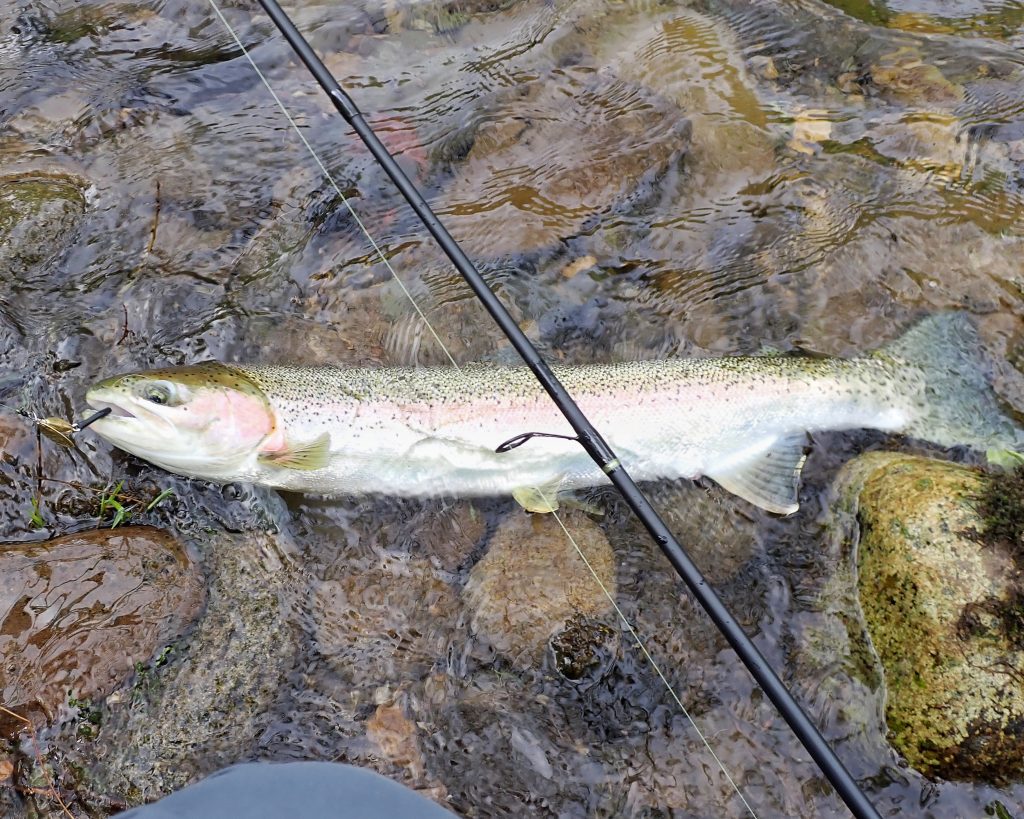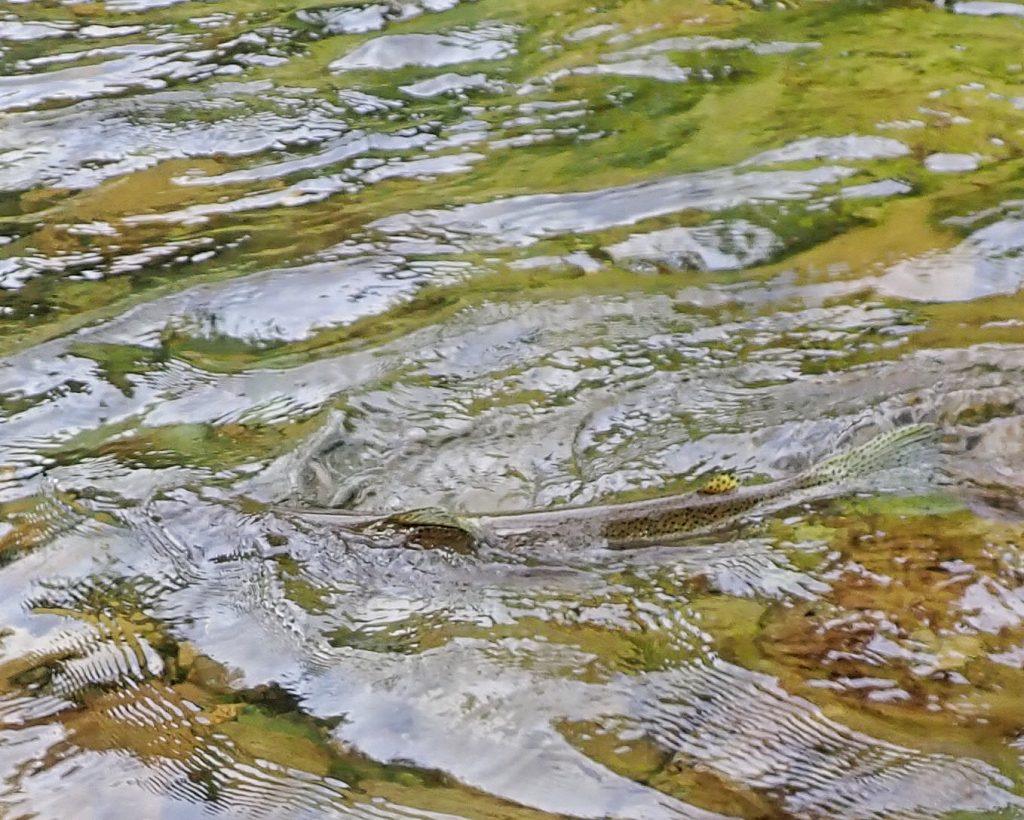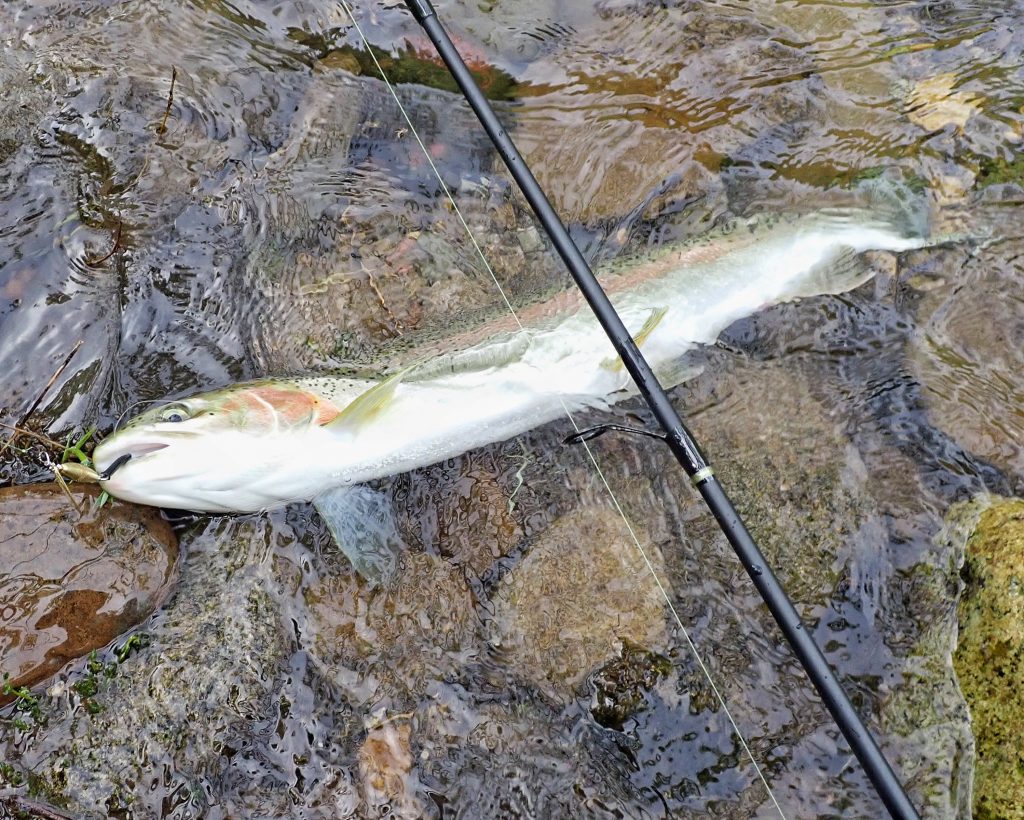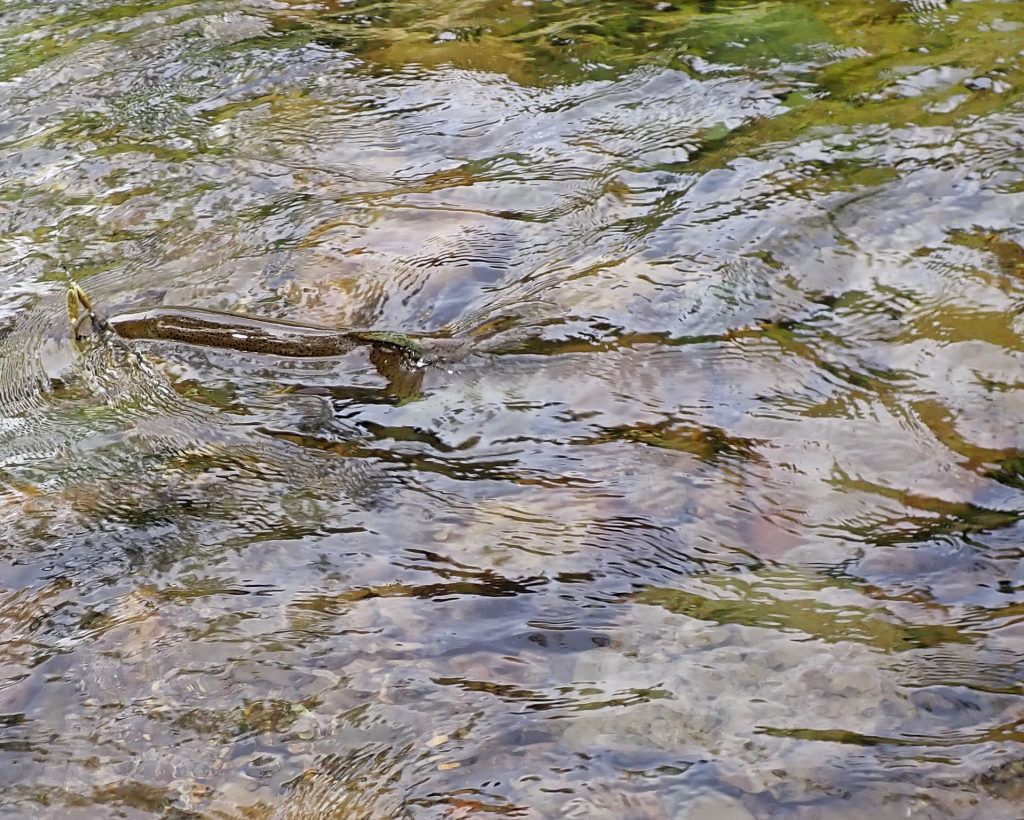
I love steelhead! I say that about many living organisms, but the truth is that I feel an admiration for, and affinity with, steelhead that goes beyond appreciation of their beauty and wonder at their lives. For one thing they are asocial (unlike Pacific salmon which begin forming pods and schools almost as soon as they have hatched), seemingly not opposed to the presence of conspecifics, but certainly not in need of being part of a group. They lead a mostly solitary existence as fry and as smolts, head to the ocean on their own schedule, and spend most of their time at sea alone, or in temporary alliance with pods of fish, usually other species of salmonids.
Another aspect of steelhead that I identify with is that they are a curious and investigative fish who, even during their spawning runs in freshwater when they do not eat, will often grab things with their only grasping tool, their mouth, just to experience it. And, in what seems to me an incredible display of endurance and fortitude and sheer will-to-live, once they have spawned they make their way back toward the ocean (although many, if not most, are not able to complete the trip due to exhaustion; and unlike Pacific salmon that always die after spawning) to recuperate, to grow and grow strong again, before their next immense journey to propagate their species.
It may seem odd at best, and perverse at worst, that I would spend so much time attempting to impale a creature I claim to love in the mouth so that I can drag them to my feet, an act which undoubtedly causes them pain and depletes their energy reserves, and I will admit that it is a very selfish act on my part. But they are simply not available for viewing in the same way that terrestrial creatures are, though I have spent significant periods of time, sans fishing rod, watching them negotiate waterfalls, and Pam teases me about how frequently I must stop at the viewing windows at Bonneville Dam to visit my ‘fish friends’. Still, being connected to one via strands of monofilament is the only way I can even partially experience them, to feel their life and their power during that wrestling match in which the odds are more or less equal, to judge by the fact that I only land a little more than half the fish I hook. And, though they know not what they agree to, they must volunteer for the wrestling match by striking my large and gaudy spinners, which imitate no known lifeforms. Long before it was ever a law I released all wild steelhead, and when I do kill a hatchery fish I say a prayer of gratitude for its sacrifice and generosity in feeding my family.

I didn’t expect to ever profile steelhead, because of my self imposed stricture against profiling organisms that were not born wild, since I hadn’t caught a wild steelhead this century (though that isn’t surprising, since I seldom fish at any time/place where they would be the primary target). But last Wednesday, while fishing for spring chinook on the Wind River in Skamania County, Washington, I hooked and landed a wild steelhead. It was something of a bittersweet experience, and the last couple minutes were probably comical to watch. The sweet part is probably obvious from my earlier remarks. The bitter part came from the fact that this fish didn’t put up the battle I’m used to from these fish, and I believe that that was because it had about 3’ of monofilament hanging from its mouth and a hook lodged in its gullet, which could’ve only happened because someone was illegally using bait, since fish in general simply do not swallow artificial lures. And the reason it’s not legal to use bait is because gut hooked fish have a high mortality rate even if the line is cut (which should be done as close to the mouth as possible so that it isn’t continually catching on things) and the purpose of releasing fish from endangered populations is so they will still be able to propagate. I was so saddened by the sallow weakness of that steelhead (and for me sadness often quickly curdles into anger), that I later shouted at an angler across the river who was clearly using bait. He quickly reeled in and left, although he probably just found a location devoid of judgemental bleeding hearts in which to ply his illicit tactics.
The comical part comes in because of my awkwardness in attempting to photograph and then release the fish with the one hand that wasn’t holding the rod, and without removing the fish from the water. It has been a law for several years that you can’t take a fish completely out of the water if it must be released, and really it is a good idea for any fish that will be released. There are several reasons for this, all of which are meant to limit stress on the fish, since stress or injury to the fish significantly raises their mortality rate. They mostly revolve around 2 issues- exposure to the air has a drying and even scorching effect on the gills, and gravity exerts a much stronger pull on organs and muscles when the fish is not in its natural habitat of being buoyed by the water.
The only real difference between steelhead and rainbow trout is that steelhead spend much of their life in saltwater and return to freshwater to spawn (the technical term is anadromous), whereas rainbows live out their lives in freshwater. Obstructions between their natal gravel and the ocean, such as high and/or vertical/overhanging falls, or dams, certainly play a part in determining whether a population is anadromous or not. But there are rivers (the Deschutes for one) that harbor wild, native, resident trout, and steelhead, and no one really knows why some have the genetic coding that both calls them to the sea, and enables the physiological adaptations that allow the transition to saltwater (smoltification), and then back to freshwater. And, interestingly, steelhead are not a subspecies of rainbows, but merely a variation within their subspecies, and anadromous parents can produce non-anadromous offspring, and vice versa. No consensus has even been reached as to whether anadromy or residency was the primal evolutionary characteristic for this species.
I apologize for the lack of photos in this profile, which is attributable to my desire to get the fish released as quickly and safely as possible. I did stop at Bonneville on my way home, but there were no steelhead (wild or hatchery) passing the windows during the 45 minutes I spent there. I will add photos if I manage to get any. I also apologize for taking up most of this post with my personal relationship with these noble fish (and, as always, I will list salient details of their life history below, as well as several links to more detailed information) but books can be (and have been) written about this species, and it was beyond my scope to paint a complete picture of their life and history.

Description-May reach over 40” and 40#, but most often between 24-30”, and 6-10#; streamlined, with a dark back and top of head, pink to red lateral line, spotted above with an entirely spotted tail; belly silvery white, greying with time spent in freshwater; entire interior of mouth white.
Similar species-All descriptions are for fish in freshwater; all male Pacific salmon have a more pronounced kype than steelhead; Chinook salmon are less streamlined, have spots below the lateral line, and have a dark mouth with black gum line; Coho salmon lack rosy lateral line, have only a few spots on the tail, (usually on the upper portion), and have a dark tongue; Chum salmon are mottled green, brown, and red, and lack spots; Sockeye and Pink salmon have a pronounced hump in their back.
Habitat-Unpolluted freshwater streams and rivers that connect to the Pacific Ocean, without barriers to migration, and with abundant, unsilted, pea-sized gravel in which to spawn.
Range-Native in Pacific Slope rivers in western North America, and on the Kamchatka Peninsula of Asia; can be found region wide in the PNW, although the vast majority of both resident and anadromous Oncorhynchus mykiss here are now of hatchery origin; there are also introduced populations of steelhead in the Midwest that utilize the Great Lakes as their ocean, and spawn in their tributaries.
Eats-Insects and other invertebrates, and probably small fish, as fry and smolts in freshwater; crustaceans and other invertebrates, and fish (herring, anchovies, candlefish, etc.) in saltwater; very limited feeding during upstream migration, opportunistic feeding when heading back to the ocean after spawning.
Eaten by-Mink, otter, raccoons, bears, larger steelhead and salmon, mergansers, osprey, bald eagles, gulls, terns, seals, sea lions, orcas, and pretty much anything else that can catch one.
Adults active-Year around; summer runs usually enter the river from May-August, and may spend up to ten months in the river; winter runs usually enter the river November-March, and spend no more than 5 months, usually only 6-8 weeks; there are also fall and spring runs; the largest wild fish usually enter the rivers in March-April, and are heading downstream within 2 months, protection of which is why most rivers are closed to fishing from March 15 until Memorial Day Weekend.
Life cycle-Usually spend 1-2 years in freshwater before migrating to the ocean, but may take up to 4 years; spend 1-3 years in the open ocean before returning to their natal river to spawn; under ideal conditions they may live up to 11 years and spawn four times, but in reality 6-8 years and two spawning runs is a long life.
Etymology of names–Oncorhynchus is from the Greek words for ‘hooked nose’, referring to the hooked jaw (kype) of spawning males, although steelhead don’t have nearly as radical of a kype as Pacific salmon do. The specific epithet mykiss is from the Chukotko-Kamchatkan language of the indigenous culture living where the first steelhead were located that were described by science, and was their name for these fish.

https://www.adfg.alaska.gov/index.cfm?adfg=steelhead.main
https://fishbio.com/one-fish-two-forms-many-questions/
https://www.fishbase.se/summary/oncorhynchus-mykiss.html
https://animaldiversity.org/accounts/Oncorhynchus_mykiss/#0e9737bd71cfbc9b88e5ee9661e1827c
https://pdfs.semanticscholar.org/7c54/38c5d40a088f786aea091101197279ac11d2.pdf
“Save the whales” begins in the headwaters and travels through the shrub-steppe. As we create more habitat for steelhead and other anadromous fish, we feed the ocean. It’s all so wonderfully and scarily interconnected.
Well said, Kat!
Thank you for the great information on the steelhead. I hope we can save the wild steelhead for our future. It is important.
It is! Thank you!!!